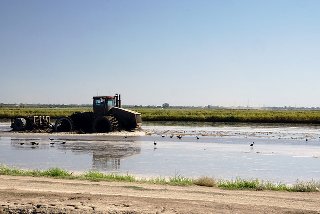When a tornado, flood, or drought strikes, or a quarantine is imposed by the Secretary of Agriculture, or when other natural disasters occur, FSA's Emergency loan program is there to help eligible farmers and ranchers rebuild and recover from sustained losses.


The Emergency loan program is triggered when a natural disaster is designated by the Secretary of Agriculture or a natural disaster or emergency is declared by the President under the Stafford Act. These loans help producers who suffer qualifying farm related losses directly caused by the disaster in a county declared or designated as a primary disaster or quarantine area. Also, farmers located in counties that are contiguous to the declared, designated, or quarantined area may qualify for Emergency loans.
For production losses, a disaster year yield that is below the normal production yield of the crop, as determined by the Agency, is required. Losses to quality, such as receiving a reduced price for flood damaged crops, may also be eligible for assistance.
Resources
Application Forms*
Download and complete the Emergency Loan Applications and Instructions:
| FSA-2001, Request for Direct Loan Assistance | Instructions |
| FSA-2309, Certification of Disaster Losses | Instructions |
| FSA-2310, Lenders Verification of Loan Application | Instructions |
*All FSA direct loan applications require the same basic forms. Emergency loan requests have 2 additional forms, the certification of disaster losses and lender verification that commercial banking assistance was denied.
When you meet with your FSA county Farm Loan Program staff, you may be asked to complete additional forms based on applicable loan program requirements for the loan type.
Emergency Loans Frequently Asked Questions
Loan Purposes
Emergency loan funds may be used to:
- Restore or replace essential property
- Pay all or part of production costs associated with the disaster year
- Pay essential family living expenses
- Reorganize the family farming operation
- Refinance certain non-real estate operating debts
Eligibility Requirements
For production losses, a disaster year yield that is below the normal production yield of the crop, as determined by the Agency, is required. Losses to quality, such as receiving a reduced price for flood damaged crops, may also be eligible for assistance.
In addition to the general eligibility requirements all loan applicants must meet, there are some additional criteria unique to the Emergency Loan program:
- the loan applicant must be an established farmer and either the owner-operator or tenant-operator of the farm at the time of the disaster
- loan applicants must intend to continue farming
- loan applicants must get written declinations of credit from organized commercial lending institutions
- If the loan is greater than $100,000 and less than $300,000, only 1 letter is required
- If the loan is greater than $300,000, 2 letters of declination are required
- If the loan amount requested is $100,000 or less, this requirement is determined on a case by case basis at the Agency's discretion
- loan applications must be received by the Agency no later than 8 months after the date the disaster is declared or designated
- the loss and/or damage to the farm operation must be directly attributed to the stated reason of the disaster declaration
- crop insurance is not required at the time of the loss but will be a requirement for the coming year in order to receive a loan
Maximum Loan Limitations
The maximum loan amount for an Emergency loan is $500,000 yet the amount a loan applicant may receive is limited to the actual amount of production or physical loss caused by the disaster. Physical loss loans are based on the amount needed to replace the lost property, such as stored grain, equipment and livestock.
Repayment Terms
Repayment terms are based on the useful life of the security, a loan applicant's repayment ability, and the type of loss involved. The repayment schedule will require at least 1 payment every year. Emergency loans for annual operating expenses must be repaid within 12 months, and not to exceed 18 months if an extended term is necessary for the production cycle of the agricultural commodity.
Interest Rate
Interest rates are calculated and posted the 1st of each month. The interest rate charged is always the lower rate in effect at the time of loan approval or loan closing for the type of loan wanted.
Additional Information
We encourage you to contact your local office or USDA Service Center to learn more about our programs and the information you will need for a complete application. You also should be able to find a listing in the telephone directory in the section set aside for governmental/public organizations under the U.S. Department of Agriculture, Farm Service Agency. Our local FSA offices are happy to help you.
